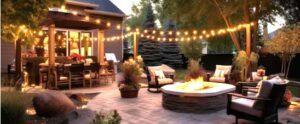Dive into everything you need to know about outdoor lighting—from creating a cozy ambiance to enhancing safety and security. Whether you’re looking to transform your garden or simply light up your patio for those summer nights,
What’s your favorite outdoor lighting tip or trick? Let’s share ideas! 💡💬
When you’re setting out to light up your outdoor space, it’s crucial to first think about what you want to achieve. Are you making your garden a nighttime paradise, or do you need your path to the door all lit up for safety? Maybe it’s both. Clear goals help in deciding the type of lights and setup you’ll need.

Think about the vibes you want your space to give. If you’re all about that cozy, warm glow for social gatherings, then softer lighting might be your jam. Or if you’re more about showcasing those killer landscaping features, brighter, focused lights could be the way. Figuring this out helps narrow down your options.
Safety and functionality can’t be ignored either. You’ll want enough light to navigate, but also not so much that it feels like a football stadium. Consider where shadows fall and how you can use them to your advantage or eliminate them if they’re a hazard.
Dig into what you’ll need tech-wise too. For any special effects or advanced setups, maybe some smart lighting solutions that you control with your phone could be just the trick. Or sticking with the basics if you like to keep it simple and traditional. Match the tech to your comfort level and style needs so everything feels just right.
Designing an Effective Lighting Layout
Getting the layout spot-on for your outdoor lights is key to making those goals come to life. It’s all about strategically placing your lights to highlight the coolest aspects of your landscape while ensuring pathways and entry points remain visible and safe.

Start by mapping out your space. Consider areas that naturally draw attention, like water features, pathways, or architectural elements. These become your focal points. Position lights to cast the right shadows and create depth, enhancing these features and making your space pop even at night.
Think about the practical side, too. Where’s your power source? Are you gonna need transformers or long cable runs? Efficient layout planning involves minimizing the distance between lights and power supplies to avoid excessive cabling, which can not only look messy but can also be a tripping hazard if not properly handled.
Layer your lighting by combining different types such as accent, task, and ambient lighting to create a balanced look. This approach ensures that your space is functional while also boasting the aesthetic charm and ambiance you’re going for.
When planning, also consider any potential future developments or installations in the garden. If you’re thinking of adding new features, keep this flexibility in mind to prevent having to overhaul your entire setup later.
A well-thought-out layout will also consider the natural features already present. Trees, shrubs, and structures should guide your lighting choices, ensuring that every element of your garden works together seamlessly to create an inviting and cohesive nighttime garden experience.
Choosing the Right Intensity and Control Options
When it comes to deciding how bright your outdoor lights need to be, it’s all about blending function with style. Different areas might require varying intensities based on their purpose. For instance, a patio seating area might benefit from a gentler, ambient light, creating a relaxing atmosphere. Meanwhile, pathways and entry points could use brighter, more focused lights for safety and guidance.
Dimming options can be a game-changer here. Adjustable lights let you customize the vibe, adapting to different times of day or events. Consider LED lights with dimmers which offer flexibility and energy efficiency. You’ll have control over the mood and can conserve energy when full brightness isn’t necessary.
Another handy modern feature is smart lighting control systems. From motion sensors that activate lights as needed, to smartphone apps that let you tweak settings from anywhere, these can add convenience and versatility to your setup. Imagine adjusting your lighting without leaving the comfort of your outdoor sofa.
Prioritize controls that align with your lifestyle. Do you prefer a set-and-forget system, or do you enjoy playing around with different settings? Your choice could also depend on how tech-savvy you are. Simpler control systems might be easier if you want something straightforward and reliable.
Considering the intensity and control options wisely will help create an adaptable and user-friendly lighting experience. It’s about having the right light, at the right time, in the right place, ensuring your outdoor living space shines no matter the occasion.
Selecting Styles and Materials to Complement Your Landscape
Choosing the right style and materials for outdoor lighting involves matching the fixtures with your landscape and personal taste. The lights you install should enhance the beauty of your garden and blend seamlessly with the environment.

Start with deciding on a style that reflects your home’s character. Do you lean towards a modern aesthetic, or does a rustic look capture your vibe? There are endless styles out there, from sleek, minimalistic designs to more ornate, traditional ones that could elevate the overall charm of your space.
Once you have a style in mind, think about materials. Consider durability, especially if you live in an area with extreme weather. Metals like stainless steel or bronze offer longevity and resilience, while options like glass and ceramic can add an elegant touch if well-protected.
Also, think sustainably by exploring eco-friendly materials. This can reduce your environmental impact without sacrificing style. Check for products made from recycled materials or those that are energy-efficient, like solar-powered lights.
Installation also plays a role in the material decision. Some materials might be heavier and require professional installation, whereas lighter options might be easier to manage for DIY enthusiasts.
Ultimately, selecting styles and materials that complement your landscape is about balancing aesthetic appeal with practical considerations. The right choices ensure your outdoor lighting serves as both a functional element and a reflection of your personal style, tying together the entire look of your outdoor space.
